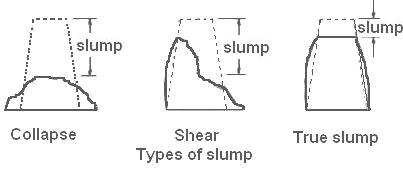Concrete Slump Test & Slump Test Procedure (Video)
Concrete Slump Test & Slump Test Procedure
What is Slump Test?
Concrete slump test also called slump cone test, is to determine the workability or consistency of concrete mix prepared at the laboratory or the construction site.
It is done to check the workability of freshly made concrete and the ease at which concrete flows. It also can be used as an indicator of a batch not properly mixed.
The test is common because of the simplicity of the apparatus or tools used and with a simple procedure. The slump test is used to make sure uniformity for different loads of concrete under field conditions.
The slump test is indirectly used to check that the correct amount of water has been added to the mix.
The slump test measures an indication of the uniformity of different batches of concrete. The shape of the concrete slumps indicates the information on the workability and quality of concrete.
The characteristics of concrete concerning the tendency of segregation can also be judged by making a few tamping or blows by tapping a rod on the base plate.
This test continues using since 1922 due to the simplicity of apparatus and simple procedure. The shape of the Slump cone shows the workability of concrete.
Concrete Slump Test Procedure
Step One
Firstly, the internal surface of the mold is cleaned carefully. It should be free from moisture or old sets of concrete. Oil can be applied to the surface.
Step Two
The mold is then placed on a base plate. The base plate should be having a non-absorbant surface and mute be smooth, horizontal, clean, and non-porous.
Step Three
The mould is filled with freshly made concrete in four layers taping the layer 25 times with a clean steel rod. The estimated diameter of this steel rod is 5⁄8 inch. This rod is rounded at the ends. The tamping should be done uniformly.
Step Four
Once the mould is filled, excess fresh concrete should be removed, and then the surface is leveled. When the mould is filled with freshly made concrete, the mould’s base is held firmly by handles.
Step Five
Then the mould is lifted gently in the vertical direction, and then unsupported concrete will slump, and it is known as ‘slump.’ This free concrete deform all the surface to subside due to the effect of gravity.
The decrease in the height of the centre of the slumped concrete is called a slump.
Step Six
The decrease in height at the center point is measured to the nearest 5mm or 0.25 inch. The height difference between the height of subsidence concrete and mould cone in mm is ‘slump value of concrete.’
Slump Test Concrete Workability
| Degree of workability | Placing Conditions | Slump(mm) |
| Very Low | Binding concrete (member of concrete by spreading, shallow sections, Pavements using pavers (mixer with spreading arrangements) | Compaction factor 0.75 – 0.8 |
| Low | Mass concrete, lightly reinforced slab, beam, wall, column sections, canal lining, strip footing (ling wall with smaller width ) | 25 – 75 |
| Medium | Heavily reinforced sections in slab, beams, walls, columns. Slip formwork (slope concrete), pumped concrete. | 50-100 |
| High | Trench fill, in-situ piling | 100-150 |
| Very high | Tremie concrete (concreting in water by using water tight pipe to pour concrete.) | Flow test. |
Test of Workability of Concrete (Slump Test)

